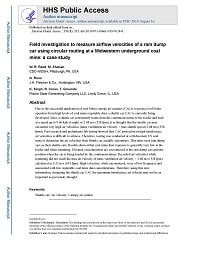Mining Publication: Field Investigation to Measure Airflow Velocities of a Ram Dump Car Using Circular Routing at a Midwestern Underground Coal Mine: A Case Study
Original creation date: August 2019
Authors: W Reed, M Shahan, G Ross, K Singh, R Cross, T Grounds
Due to the successful application of roof bolter canopy air curtains (CACs) to protect roof bolter operators from high levels of coal mine respirable dust, a shuttle car CAC is currently being developed. Since a shuttle car consistently trams from the continuous miner to the feeder and back at a speed up to 9.66 kph (6 mph) or 2.68 m/s (528 fpm), it is thought that the shuttle car may encounter very high air velocities (mine ventilation air velocity + max shuttle speed (2.68 m/s (528 fpm)). Past research and preliminary lab testing showed that CAC protection in high interference air velocities is difficult to achieve. Therefore, testing was conducted at a Midwestern US coal mine to determine the air velocities their shuttle car actually encounters. This mine used ram dump cars as their shuttle cars. Results showed that coal mine dust exposure is generally very low at the feeder and when tramming. Elevated concentrations are encountered at the ram dump car operator position when the car is being loaded by the continuous miner. Recorded air velocities while tramming did not reach the max air velocity of mine ventilation air velocity + 2.68 m/s (528 fpm) calculated as 3.32 m/s (653 fpm). High velocities, while encountered, were of low frequency and associated with low respirable coal mine dust concentrations. Therefore, using this new information, designing the shuttle car CAC for maximum interference air velocity may not be as important as previously thought.

- Canopy Air Curtain to Reduce Respirable Coal Mine Dust Exposure for Shuttle Car Operators
- Development of a canopy air curtain to reduce roof bolters' dust exposure
- Development of a Roof Bolter Canopy Air Curtain for Respirable Dust Control
- Emerging Technologies Control Respirable Dust Exposures for Continuous Mining and Roof Bolting Personnel
- Field Investigation to Measure Airflow Velocities of a Shuttle Car Using Independent Routes at a Central Appalachian Underground Coal Mine
- A Field Study of a Roof Bolter Canopy Air Curtain (2nd Generation) for Respirable Coal Mine Dust Control
- Laboratory Evaluation of a Canopy Air Curtain for Controlling Occupational Exposures of Roof Bolters
- Technology News 463 - Machine-Mounted Continuous Respirable Dust Monitor
- Technology News 509 - A New Method to Clean Dust From Soiled Work Clothes
- Whole-Body Vibration Exposure Comparison of Seat Designs for Low- and Mid-Seam Shuttle Cars in Underground Coal Mines